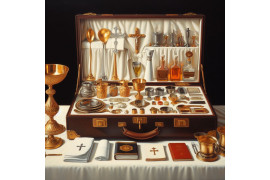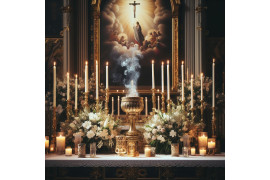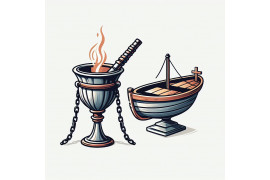Ever wondered why the Holy Grail, that elusive and sacred object of Arthurian legends, is often depicted as a chalice? It's not just a random choice. The chalice holds deep symbolism, representing purity and divine power in connection to the Holy Grail. Legends suggest that this revered vessel was none other than the very chalice used by Jesus during the Last Supper.
Imagine holding in your hands the actual chalice that Christ himself drank from during that momentous Passover meal. It becomes more than just an ordinary cup; it becomes a vessel of profound significance, holding within it the precious blood of Christ. In religious ceremonies such as Holy Communion, priests handle these sacred vessels with the utmost reverence.
So, why is it called a chalice? Join us as we delve into the origins and symbolism behind this ancient artifact, exploring its connection to the Last Supper and its role in Christian traditions. Discover how this simple goblet became imbued with such spiritual power throughout history.
Distinction between Chalice and Cup in Catholicism
In Catholicism, the term "chalice" holds a distinct meaning and purpose compared to an ordinary drinking cup. The use of the word "chalice" refers specifically to the vessel used for consecrating wine during Mass, while a cup is typically associated with everyday use.
Unlike an ordinary drinking cup, a chalice carries deep religious significance within the Catholic faith. It is considered sacred and blessed by a priest before it can be used for the Eucharist. This act of blessing enhances its sanctity and sets it apart from a regular cup.
The distinction between a chalice and a cup highlights the reverence and respect that Catholics hold for the Eucharist. The Eucharist, or Holy Communion, is one of the central sacraments in Catholicism, representing the body and blood of Jesus Christ. As such, using a specially designated vessel like a chalice emphasizes its importance and solemnity.
According to the Catholic Encyclopedia, there are specific requirements for a vessel to be considered a valid chalice. It should be made from noble materials such as gold or silver, reflecting its significance as an instrument for holding the Precious Blood of Christ. It should have certain dimensions and design elements that adhere to liturgical norms.
The use of a chalice during Mass also serves as a visual reminder of Jesus' Last Supper with his disciples. During this meal, Jesus took bread and wine, offering them as his body and blood to his followers. By using a chalice during Mass, Catholics symbolically participate in this profound event.
Moreover, employing different vessels for different purposes helps maintain order within religious rituals. Just as priests wear special vestments and use specific prayers during Mass, utilizing distinct vessels like the chalice reinforces the sacredness of each element involved in worship.
Understanding the Significance of the Chalice in Religious Sacraments
The chalice holds a significant role in religious sacraments, particularly within Catholicism. Let's delve into the in-depth meaning behind this vessel and its importance to believers.
The Chalice Represents Christ's Blood During Communion
One of the primary reasons why it is called a chalice is because it symbolizes Christ's blood during the sacred act of Communion. According to Christian beliefs, Jesus Christ offered his body and blood as a sacrifice for humanity's sins. The chalice serves as a visual representation of this act, reminding believers of Christ's ultimate sacrifice and redemption.
It Symbolizes Spiritual Nourishment through Christ's Body and Blood
The chalice holds great significance as it serves as a focal point for believers to partake in the spiritual nourishment provided by Christ's body and blood. In Catholicism, during the Eucharistic celebration, bread and wine are consecrated by priests to become the body and blood of Jesus Christ. The chalice contains the consecrated wine, which represents the blood of Christ that brings spiritual nourishment to those who partake in Communion.
Catholics Believe They Receive Grace Through the Chalice
For Catholics, receiving Communion from the chalice is not just a symbolic act but also believed to be an opportunity to receive divine grace. It is through this sacrament that Catholics believe they enter into communion with God, experiencing His presence and receiving His blessings. By drinking from the chalice, believers seek spiritual renewal and connection with their faith.
Personal Connection with God Through Communion
The use of the chalice during Communion provides a personal connection between individuals and God. As believers drink from it, they engage in an intimate act that signifies their acceptance of God's love and forgiveness. This personal connection strengthens their relationship with Him and allows them to experience His presence in their lives.
The Chalice as a Symbol of Unity and Community
Beyond its individual significance, the chalice also represents unity and community within religious gatherings. When believers come together to partake in Communion, they share in the same cup, symbolizing their shared faith and commitment to God. It serves as a reminder that they are all part of a larger spiritual family, united by their belief in Christ's sacrifice.
Crafting a Liturgical Chalice: Art and Process
Skilled Artisans Creating Sacred Vessels
Crafting a liturgical chalice is no ordinary task. Skilled artisans pour their heart and soul into meticulously creating these sacred vessels used in religious sacraments. Using precious metals like gold or silver, they bring to life vessels that hold deep symbolic meaning within the liturgy.
Intricate Designs for Reverence and Beauty
One of the distinguishing features of a liturgical chalice is the intricate designs engraved or embossed on its surface. These designs serve multiple purposes - they add beauty to the vessel while also conveying symbolism relevant to the religious context. From delicate filigree patterns to detailed depictions of religious figures, each design element holds significance within the liturgy.
Traditional Techniques Passed Down Through Generations
The process of crafting a liturgical chalice involves employing traditional techniques that have been passed down through generations. Craftsmen utilize methods such as casting, soldering, and polishing to shape and refine these sacred vessels. Each step requires precision and skill honed over years of practice, ensuring that every chalice is crafted with the utmost care.
Bringing Sacred Vessels to Life
Crafting a liturgical chalice involves several stages that culminate in bringing it to life. The journey begins with selecting the appropriate materials, often opting for noble metals like gold or silver due to their association with purity and value. Once the material is chosen, it undergoes various processes such as melting, casting into molds, and shaping using specialized tools.
Next comes the intricate work of engraving or embossing designs onto the surface of the chalice. This meticulous detailing requires patience and expertise as craftsmen delicately etch symbols or scenes onto the metal's surface.
Afterward, attention shifts towards joining different components together through soldering techniques. This ensures structural integrity while maintaining an aesthetically pleasing appearance. Finally, the chalice undergoes a polishing process to achieve a radiant and reflective surface, ready to be used in religious ceremonies.
The Significance of Liturgical Chalices
Liturgical chalices hold immense significance within religious sacraments. They are not merely drinking vessels, but vessels consecrated for sacred purposes. According to the Roman Missal, during the Eucharistic celebration, wine is poured into the chalice and consecrated, representing the blood of Christ.
The design and craftsmanship of liturgical chalices enhance the reverence and solemnity of these religious rituals. They serve as a visual reminder of the sacredness of the Eucharist, symbolizing Christ's presence among believers.
Evolution of the Chalice: Faith, Mythology, and Transformation
Throughout history, various cultures have used different types of vessels similar to today's chalices for religious rituals. The concept of using an ornate cup or goblet has evolved across different faith traditions.
Theological Significance: New Testament and Disciples
In the context of Christianity, the use of a chalice holds great theological significance. In the New Testament, during the Last Supper, Jesus shared wine with his disciples using a cup. This act is believed to have established the tradition of using a chalice in Christian worship. The chalice represents the blood of Christ and symbolizes spiritual nourishment and redemption.
Influence of Mythology: Magical and Transformative Cups
Myths surrounding magical or transformative cups have influenced how we perceive and understand modern-day chalices. One such example is the Holy Grail from the Arthurian legends. This mythical cup was said to possess extraordinary powers, including granting eternal youth and infinite abundance. The quest for the Holy Grail became a metaphorical journey representing spiritual enlightenment and personal transformation.
Historical Artifacts: Tracing Chalices through History
To gain insight into the origins and evolution of chalices, historians study ancient artifacts related to religious practices. These artifacts provide valuable information about their form, materials used, and cultural significance. For example, archaeologists have discovered metal chalices dating back thousands of years in various parts of the world.
Interpretation and Translation: Language Matters
The interpretation and translation of religious texts play a crucial role in shaping our understanding of why chalices are called as such. Different languages may use distinct words to refer to these sacred vessels. For instance, in some translations, "chalice" may be referred to as "cup," "goblet," or other terms depending on linguistic nuances.
Material Composition: Metal Craftsmanship and Symbolism
Chalices are often crafted from precious metals such as gold, silver, or bronze. The choice of material holds symbolic significance and reflects the reverence associated with religious rituals. The metal constitution of a chalice can also impact its aesthetic appeal and durability.
Design Elements: Stem, Bowl, and Base
The design elements of a chalice contribute to its overall appearance and functionality. Chalices typically consist of three main parts: the stem, the bowl, and the base. The stem provides stability while connecting the bowl to the base. The bowl is where wine or other sacred liquids are held during religious ceremonies.
Cultural Variations: Chalices Around the World
Chalices come in various shapes, sizes, and materials across different cultures. For example, in some traditions, chalices may be adorned with gemstones like agate or feature intricate engravings representing cultural symbols or stories. These variations reflect the diversity of religious practices worldwide.
The Chalice's Sacred Role in Medieval England
Chalices held a significant place of honor and reverence during the Middle Ages in England. These precious vessels were adorned with exquisite craftsmanship and often embellished with precious gemstones, showcasing their importance within the religious context.
In medieval England, chalices played a central role in religious ceremonies, particularly during Mass. They were used by priests and bishops to hold the consecrated wine, which symbolized the blood of Christ. The chalice itself represented the divine connection between God and humanity, emphasizing the importance of faith in the lives of believers.
The use of chalices in churches dates back centuries, with their origins tracing back to ancient times. The Liber Pontificalis, a book that documented the lives of popes throughout history, mentions chalices being used as early as the 4th century. Over time, these sacred vessels evolved both in design and purpose.
During the Middle Ages, chalices became more elaborate and ornate. They were crafted from precious metals such as gold or silver and often adorned with intricate engravings or filigree work. Gemstones like emeralds, rubies, or sapphires were added to enhance their beauty and symbolism.
The purpose of these elaborate designs was twofold: to honor God through their opulence, and to inspire awe and reverence among worshipers. The intricate craftsmanship served as a visual representation of the grandeur and majesty associated with religious ceremonies.
Chalices were not only found in large cathedrals but also in smaller parish churches throughout medieval England. Each church would have its own unique chalice, reflecting its individuality while still adhering to certain design principles dictated by tradition.
These sacred vessels were carefully handled by priests during Mass, ensuring that they remained clean and pure for their intended purpose. Special care was taken when preparing them for use during the Eucharist, as they were considered vessels of great importance and significance.
The chalice's sacred role extended beyond the Mass itself. It was often used during other religious ceremonies, such as baptisms or weddings, symbolizing the presence of God in these moments of spiritual significance.
Unveiling the Enigma - Why it is Called a Chalice
Congratulations! You've embarked on a fascinating journey exploring the origins and significance of the chalice. From unraveling its distinction from a cup in Catholicism to understanding its sacred role in religious sacraments, you've delved deep into the rich tapestry of history and faith. As we conclude this exploration, let's take a moment to reflect on what we've discovered.
The chalice, my friend, is more than just an ornate vessel; it symbolizes spiritual connection and divine grace. Just like a river flowing through time, it carries the essence of faith, mythology, and transformation. Crafted with meticulous artistry and devotion, it stands as a testament to human creativity and devotion. Its sacred role in medieval England echoes through centuries, reminding us of our shared heritage and the power of belief.
Now that you have unraveled some of the mysteries surrounding the chalice, I invite you to continue your quest for knowledge. Explore further into its captivating history, or perhaps even seek out a chalice of your own to hold in your hands—a tangible reminder of the spiritual journey we all embark upon.
FAQs
What materials are commonly used to craft liturgical chalices?
Liturgical chalices are often crafted using precious metals such as gold or silver. These materials add beauty and symbolize purity and reverence for the sacraments they hold.
Can anyone drink from a liturgical chalice during communion?
In most Christian traditions, only ordained clergy or authorized ministers partake from the liturgical chalice during communion. This practice ensures respect for the sacred nature of the sacrament.
Are there different types of chalices used in different religious traditions?
Yes! Different religious traditions may have variations in their use of chalices. For example, Catholicism has specific guidelines for liturgical vessels like the chalice, while other Christian denominations may have their own practices and designs.
How can I care for a chalice if I own one?
To care for a chalice, handle it with clean hands and avoid using abrasive materials that could damage the surface. Regularly clean it with gentle soap and water, taking care to dry it thoroughly. Store it in a safe place when not in use.
Can I purchase a chalice for personal use?
Absolutely! There are various retailers and online marketplaces where you can find beautiful chalices for personal use. Whether you seek one for religious or decorative purposes, be sure to choose a reputable seller to ensure authenticity and quality craftsmanship.



